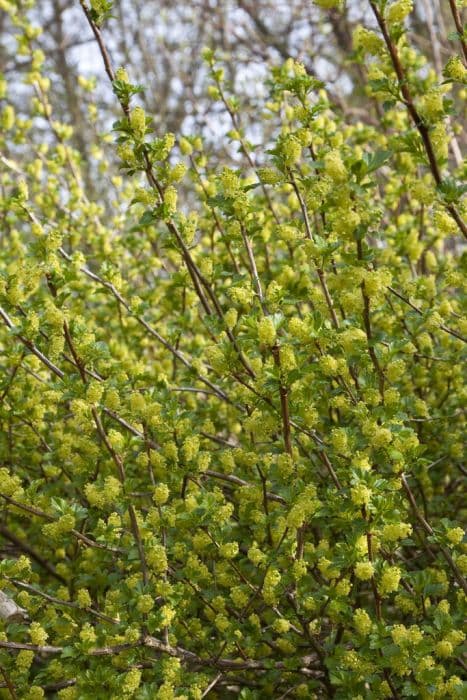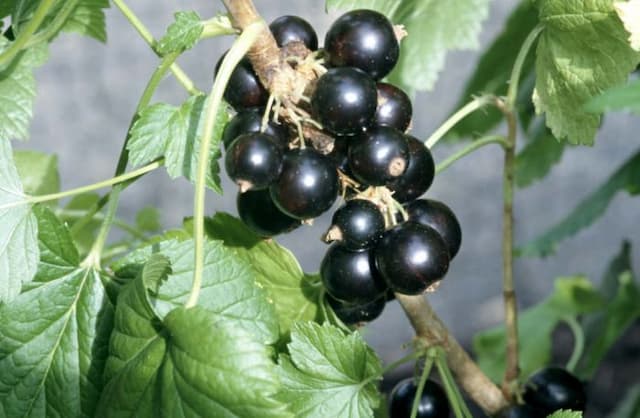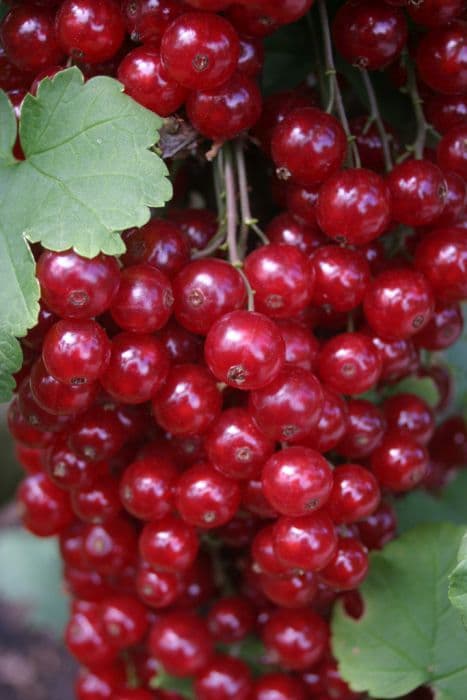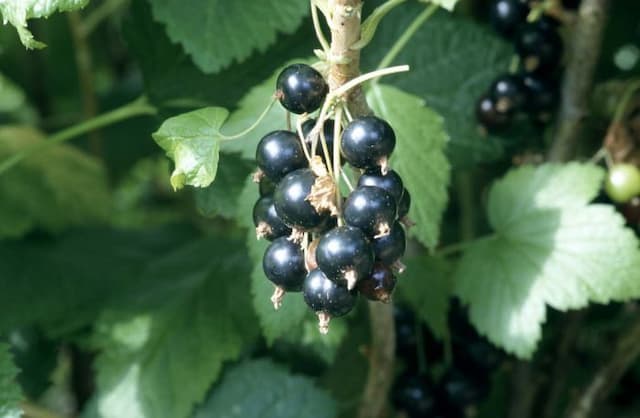Clove Currant Ribes odoratum

ABOUT
Ribes odoratum, commonly known as clove currant, is a deciduous shrub known for its attractive qualities and fragrant flowers. The plant typically bears rounded leaves that are green and heart-shaped with three to five lobes and toothed edges, giving it a lush, textured appearance. In spring, clove currant produces small, bright yellow flowers which exude a strong, spicy, clove-like fragrance, contributing to its common name. These flowers hang in clusters, providing a striking visual against the green foliage. Following the flowering period, clove currant develops small, round fruits. The fruits start green and ripen to a glossy black. They are edible and often enjoyed by birds and humans alike. Throughout the seasons, the foliage of clove currant can change hues, turning to lovely shades of yellow or red in the autumn, adding another layer of visual interest before the leaves drop for winter. The bark of the plant is smooth and becomes lightly furrowed as it matures, lending a subtle texture to the landscape. Overall, the appearance of clove currant is characterized by its fragrant flowers, attractive fruit, and appealing seasonal foliage.
About this plant
 Names
NamesFamily
Grossulariaceae.
Synonyms
Clove Currant, Buffalo Currant, Golden Currant, Missouri Currant, Spice Bush.
Common names
Ribes aureum var. villosum, Ribes fragrans, Ribes odoratum var. villosum.
 Characteristics
CharacteristicsLife cycle
Perennials
Foliage type
Deciduous
Color of leaves
Green
Flower color
Yellow
Height
6 feet (1.83 meters)
Spread
6 feet (1.83 meters)
Plant type
Shrub
Hardiness zones
4
Native area
North America
Benefits
 General Benefits
General Benefits- Attracts Wildlife: Ribes odoratum is known for attracting bees, butterflies, and birds, providing them with nectar and habitat.
- Edible Fruits: The plant produces berries that are edible for humans and can be used in jellies, jams, and pies.
- Aesthetic Appeal: With its attractive yellow flowers in spring and blue-green foliage, it adds ornamental value to gardens.
- Drought Tolerance: Once established, it is relatively drought-resistant, making it suitable for low-water-use gardens.
- Easy Propagation: It can be easily propagated from cuttings, making it easy for gardeners to expand their collection.
- Cold Hardy: Ribes odoratum is cold-hardy, which allows it to survive and thrive in cooler climates.
- Natural Barrier: The thorny nature of the plant can make it a good choice for natural fencing and barriers in the landscape.
 Medical Properties
Medical Properties- Antioxidant: Ribes odoratum contains antioxidants which may help in reducing oxidative stress in the body.
- Anti-inflammatory: The plant may possess anti-inflammatory properties that could aid in reducing inflammation.
- Diuretic: Traditionally, some parts of the plant may have been used to promote urine production, aiding in detoxification and kidney health.
 Air-purifying Qualities
Air-purifying QualitiesThis plant is not specifically known for air purifying qualities.
 Other Uses
Other Uses- Ribes odoratum, commonly known as clove currant, can be used in perfumery due to its strong fragrance reminiscent of cloves, which is particularly noticeable in the spring during its flowering season.
- The leaves of the clove currant can be infused in hot water to create a natural insect repellent, which can be useful in organic gardening practices.
- The pectin-rich fruit of the clove currant may be used in the homemade jam and jelly making, offering a unique flavor profile different from the more common fruits.
- The shrub's dense growth habit makes it suitable for use as a natural windbreak or privacy screen in garden landscapes.
- Clove currant can be planted as part of a wildlife garden, as its flowers attract pollinators like butterflies and bees, while its berries provide food for birds.
- The plant's wood can be used in specialized crafts such as the making of small wooden tools or for adding flavor when grilling foods due to its aromatic properties.
- Dried branches of clove currant can be used in floral arrangements or as part of a potpourri mix, lending a subtle fragrance to a room.
- These plants can be utilized in a dyeing process, with the berries and leaves offering potential natural dyes for fabrics or art projects.
- Landscapers might incorporate clove currant into erosion control plans, as its root system helps stabilize soil on slopes or banks.
- The vivid fall foliage of clove currant adds ornamental value to gardens and public parks, providing seasonal color transitions from green to a vibrant yellow or sometimes red.
Interesting Facts
 Feng Shui
Feng ShuiThe Clove Currant is not used in Feng Shui practice.
 Zodiac Sign Compitability
Zodiac Sign CompitabilityThe Clove Currant is not used in astrology practice.
 Plant Symbolism
Plant Symbolism- Renewal: Also known as clove currant, Ribes odoratum typically heralds the arrival of spring with its early blooms, symbolizing new beginnings and the renewal of the natural world.
- Sweetness: The sweet-scented flowers of the clove currant are often associated with the sweetness of life and the enjoyment of pleasant experiences and memories.
- Protection: Like many berry-producing plants, clove currant is sometimes seen as a symbol of protection, offering sustenance and shelter to wildlife, thus embodying the idea of nurturing and safeguarding loved ones.
- Prosperity: The abundance of fruit produced by clove currant can symbolize prosperity and fertility, suggesting a period of growth and abundance in one's life.
 Water
WaterThe Clove Currant requires regular watering, particularly during its active growing season in the spring and summer. During these months, it's necessary to water the plant deeply once a week, ensuring that you soak the soil thoroughly with about 1 to 1.5 gallons of water per session. The goal is to maintain a consistently moist soil environment without overwatering and causing standing water or soggy conditions, which can lead to root rot. During the fall and winter months, reduce watering frequency as the plant's water requirements decrease due to dormancy. Always check the top inch of the soil before watering; it should be dry to the touch, indicating the need for more water.
 Light
LightThe Clove Currant thrives in full sun to partial shade conditions. It will do best in a location where it can receive at least four to six hours of direct sunlight daily, which promotes healthy growth and abundant flowering. If planted in too much shade, the plant might not bloom as prolifically and could become leggy as it stretches towards the light.
 Temperature
TemperatureThe Clove Currant is a hardy plant that can tolerate a range of temperatures. It's capable of withstanding winter lows down to -30 degrees Fahrenheit and summer highs up to 90 degrees Fahrenheit. However, the ideal growing temperatures for the Clove Currant are between 60 and 75 degrees Fahrenheit, which encourage optimal growth and blooming.
 Pruning
PruningPruning the Clove Currant is important to maintain its shape, remove any dead or diseased wood, and encourage the growth of new, healthy branches. The best time to prune this plant is in late winter or early spring before new growth starts. Annual pruning, by removing about one-third of the oldest stems, will invigorate the plant and help to increase air circulation and sunlight penetration within the canopy.
 Cleaning
CleaningAs needed
 Soil
SoilClove currant, the common name for Ribes odoratum, thrives in well-draining soil with a pH range of 5.5 to 7. The ideal soil mix for clove currant should be rich in organic matter, such as a blend of loam, peat, and sand or perlite. Amending the soil with compost can improve fertility and help retain moisture without becoming waterlogged.
 Repotting
RepottingClove currant generally does not require frequent repotting and can thrive outdoors where it has room to spread. Repot young clove currant plants every 2-3 years to ensure they have adequate space to grow. Mature plants are typically not repotted but may need soil replenishment or division if they outgrow their space.
 Humidity & Misting
Humidity & MistingClove currant prefers moderate to high humidity levels but is quite adaptable and can tolerate the normal humidity found in most outdoor environments. Providing a layer of mulch can help maintain the soil moisture level, thus indirectly contributing to the local humidity conditions beneficial for the plant.
 Suitable locations
Suitable locationsIndoor
Place clove currant in bright, indirect light indoors.
Outdoor
Full sun to partial shade and well-drained soil for clove currant.
Hardiness zone
4-8 USDA
 Life cycle
Life cycleRibes odoratum, commonly known as Clove Currant or Buffalo Currant, begins its lifecycle as a seed, which after dispersing from the ripe fruit, germinates in spring - this may take one or more growing seasons, as the seeds require stratification to break dormancy. Once germination occurs, the seedling emerges and establishes a root system and foliage; it reaches the juvenile phase, focusing on vegetative growth. As the plant matures, it advances to the adult vegetative stage, at which point it develops woody stems and a more extensive root system. Upon reaching reproductive maturity, Clove Currant produces fragrant, yellow flowers in early spring, which are pollinated by insects, primarily bees. Following pollination, the flowers develop into dark purple, edible berries that ripen through the summer. Once the fruit is dispersed or consumed by wildlife, and the cold period facilitates seed stratification, the cycle can start anew, with seeds entering a dormancy phase through winter until conditions are suitable for germination.
 Propogation
PropogationPropogation time
Spring-early summer
Propogation: The most popular method for propagating the plant commonly known as clove currant (Ribes odoratum) is by softwood cuttings. This process typically occurs in late spring to early summer when new growth is soft and flexible. Cuttings should be about 4 to 6 inches long, with the lower leaves removed. The base of the cuttings is dipped in rooting hormone to encourage root development and then planted in a mix of peat and perlite or sand to provide good drainage. The cuttings need to be kept moist and in a well-lit area but out of direct sunlight until roots have established, which can take several weeks. Once rooted, the cuttings can be transplanted to a more permanent location in the garden.








